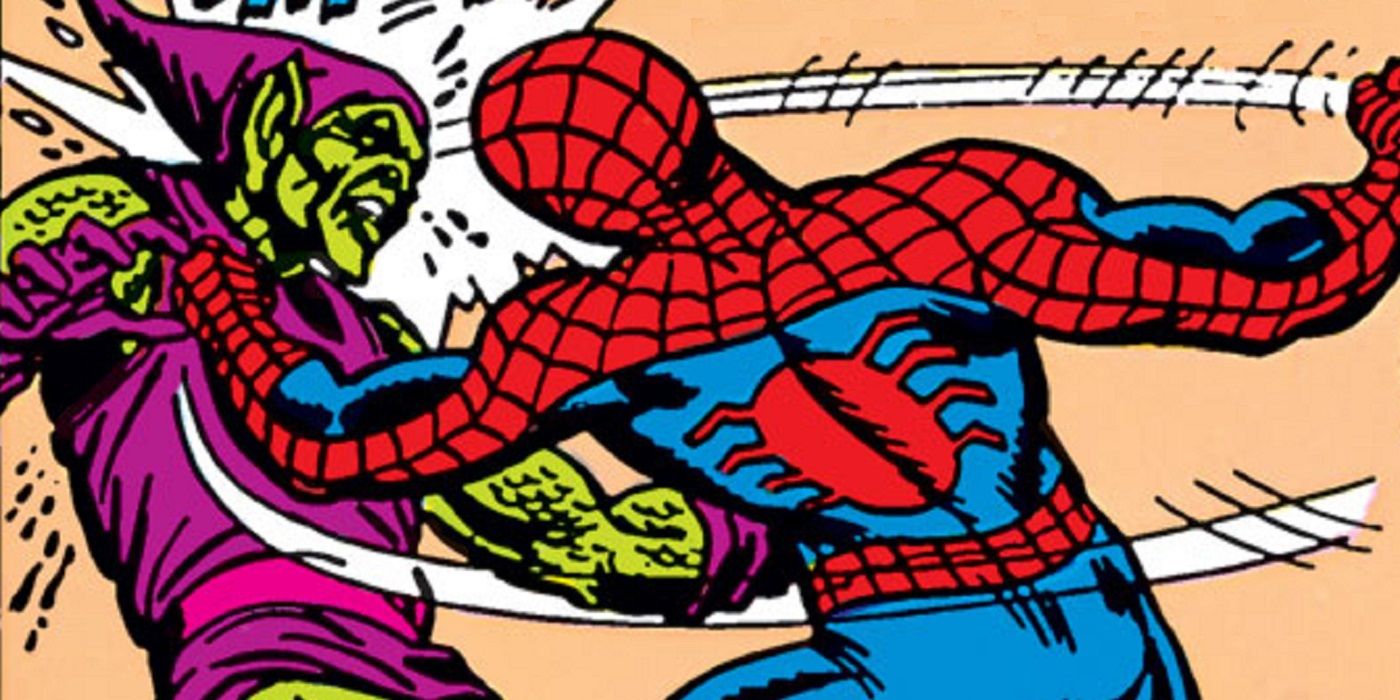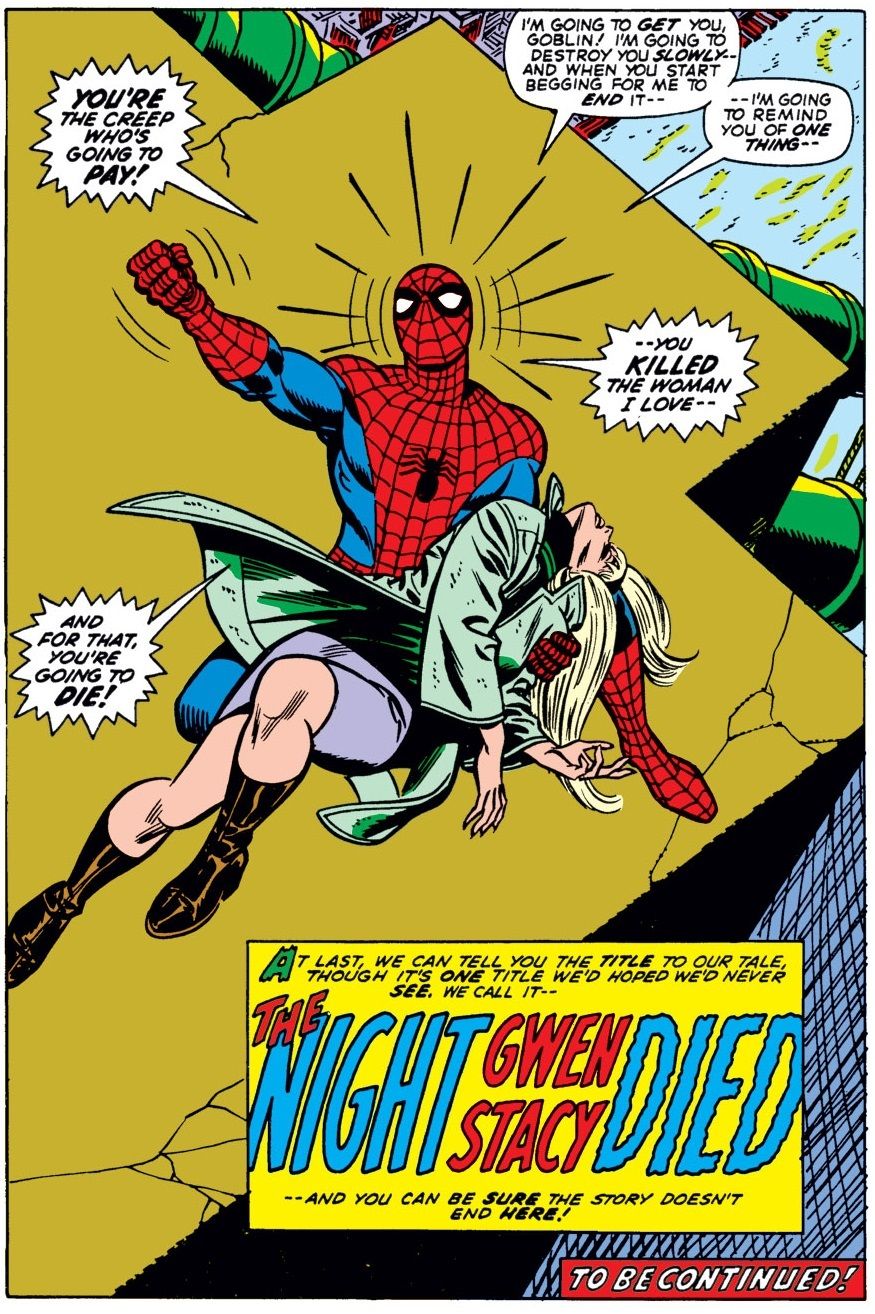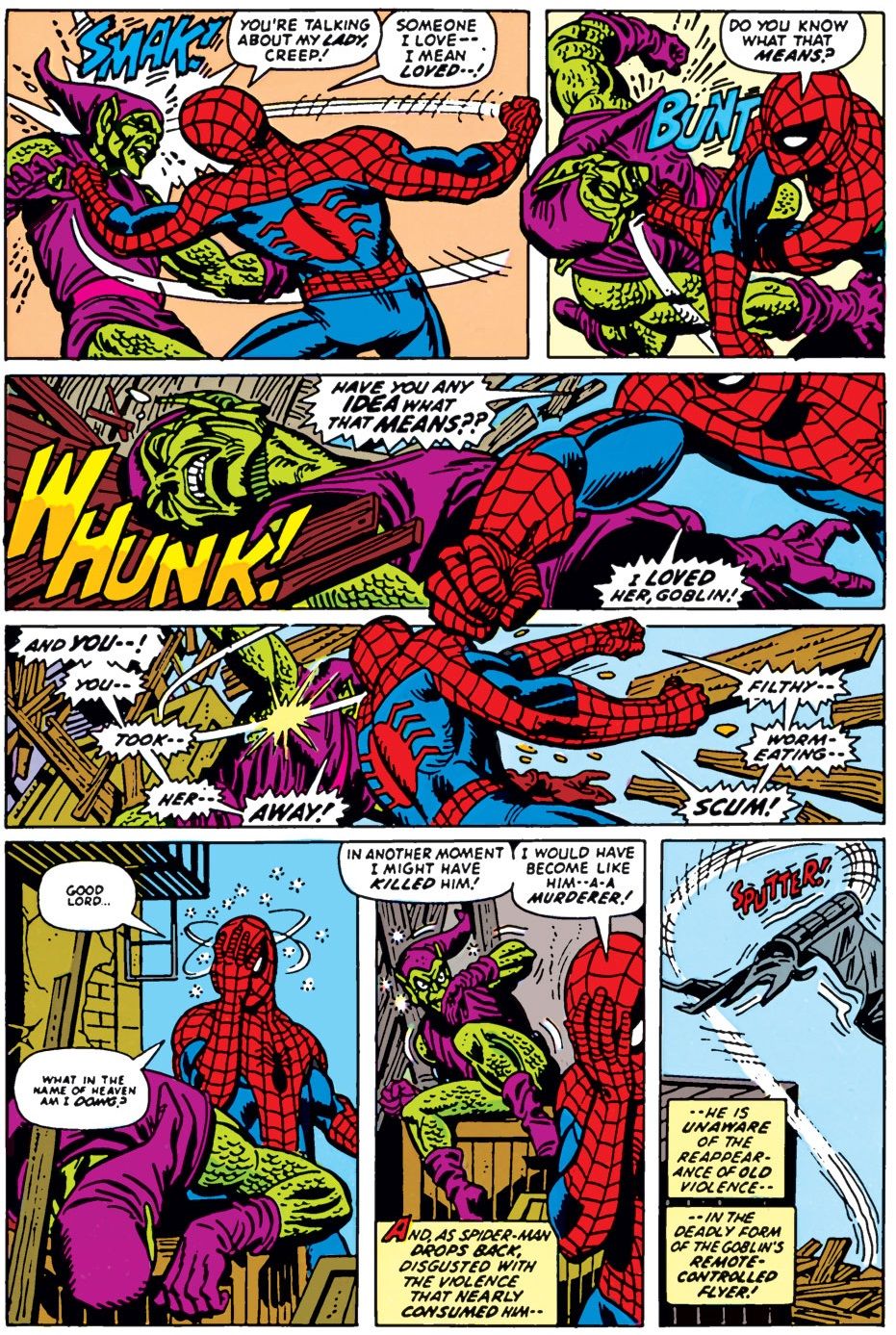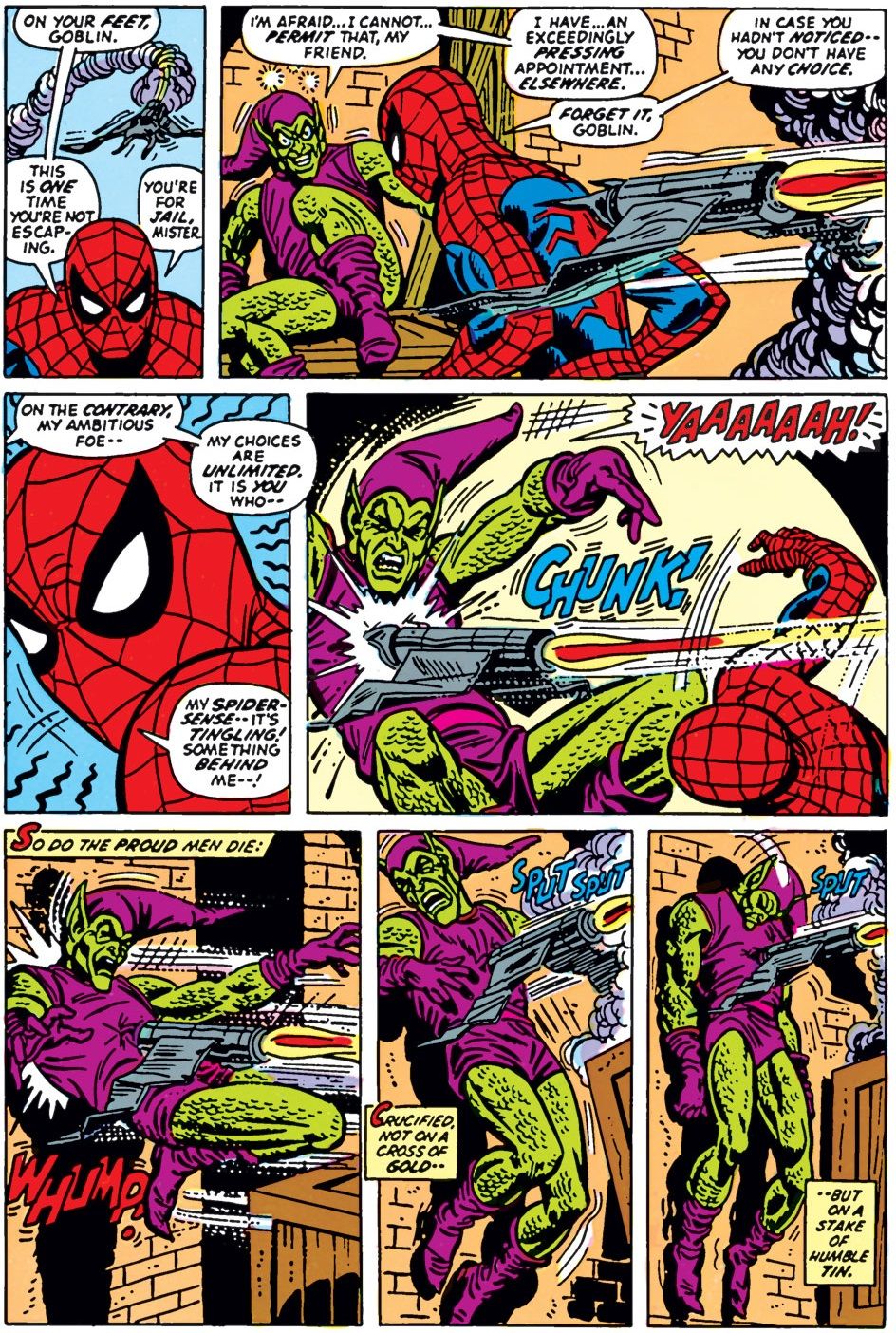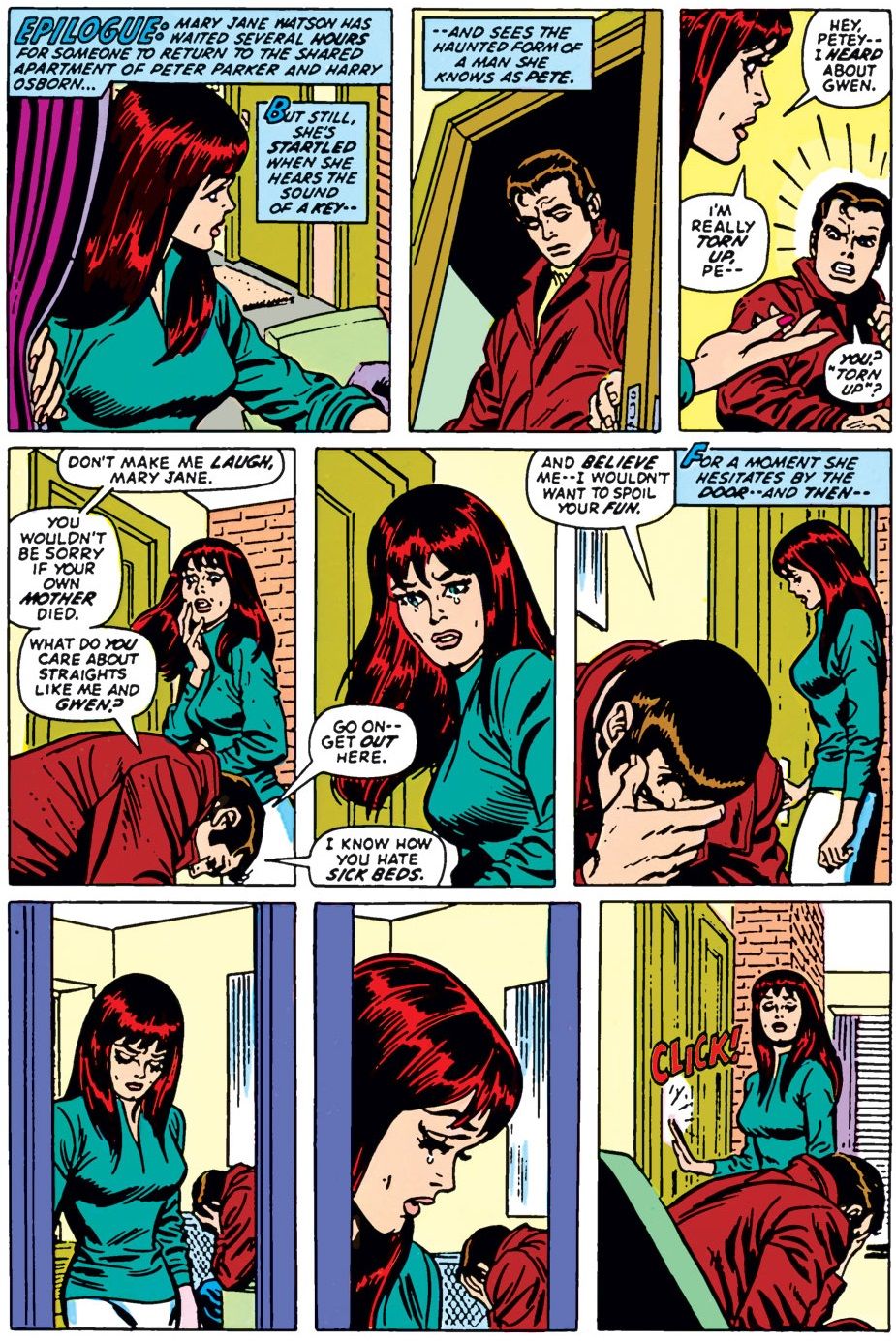In every Look Back, we examine a comic book issue from 10/25/50/75 years ago (plus a wild card every month with a fifth week in it). This time around, we head to April 1973 to see how Green Goblin paid the ultimate sacrifice for his role in the Death of Gwen Stacy.
Last time around (which I spotlighted in this disguised Look Back), we took a look at Amazing Spider-Man #121 (by Gerry Conway, Gil Kane, John Romita and Tony Mortellaro), which saw Norman Osborn regain his memory that he was the Green Goblin, run out and kidnap Peter Parker's girlfriend, Gwen Stacy, take her to the top of a bridge, and throw her off of it. Spider-Man tried to save her, but in the process, his webbing accidentally snapped her neck (which is hilarious, not because of how tragic it was, but because every Spider-Man writer just ignored that for DECADES until suddenly they all seemed to understand how truly messed up that was at the same time, and then, like, three dozen Spider-Man writers all wrote stories about how guilty Spider-Man felt about the fact that his webbing killed her while trying to save her).
The issue ended with Spdier-Man declearing that he was going to kill the Green Goblin to avenge Gwen's death. Well, the Green Goblin dies in April 1973's Amazing Spider-Man #122 (by Conway, Kane, Romita and Mortellaro), but rest assured, Spider-Man doesn't do the deed. Instead, the Green Goblin's own villainy (and terrible vehicular design) does him in.
How did the Green Goblin perish?
So Spider-Man pretty quickly plans to kill the Green Goblin right then and there, but the Goblin escapes. Peter heads back to Gwen's body. By this time, a bunch of cops show up, and obviously, a few of them think that Spider-Man killed Gwen. Another cop sticks up for Spidey, but Spidey then essentially says he IS responsible for her death (because that's what he feels). The cops then try to take him in, but he escapes.
A distraught Peter heads to Harry Osborn's apartment to see if Norman is there, but it is just Harry, who is still dealing with the effects of too much LSD in the previous issue. An unfeeling Peter walks away from the still-messed-up Harry, as Peter has no time for anything but finding (and killing) Norman Osborn. Spider-Man then gets a hint from the Daily Bugle to where Green Goblin has last been seen (in a scene that has always seemed to me to be Robbie Robertson saying he knows Peter is Spider-Man). Spider-Man heads off to kill the Green Goblin.
However, let's face it, Spider-Man isn't a killer.
He beats the villain up, but decides not to actually kill him. At the end of the day, Spider-Man is too much of a hero to just murder a guy for revenge. However, this IS a super-villain we're dealing with here, which means that Green Goblin doesn't have the same anti-killing policy.
My pal Chris Nowlin alerted me to a great line in Green Goblin's first appearance where he explained that he rode a flying broomstick because it had little chance for fatal error. He then "upgraded" to the Goblin Glider, and sure enough, this glider DOES have room for fatal error, as the Goblin is killed by his own glider, while intending for it to kill Spider-Man...
There's a great Simpsons joke about how, in the future, Mister Burns is being frozen until they can find a cure for what killed him. As it turns out, what killed him was seventeen stab wounds in the back.
Well, as it turned out, Norman Osbron actually had a cure for a glider puncture to his heart, as he came back alive years later.
Why was this issue such a big deal for Mary Jane Watson?
One of the side factors in Gerry Conway wanting Gwen Stacy to die is that Conway found Mary Jane Watson to be a much more compelling love interest for Peter Parker. That was obviously NOT what Stan Lee or John Romita felt, as their stories typically had Mary Jane coming off very poorly. Peter, under Lee's pen, said some nasty things about Mary Jane that sure didn't suggest that he thought much about her. In the wake of Gwen's death, though, that was set to change. It would occur with one of the most famous sound effects in Spider-Man history.
Mary Jane is waiting for Peter when he gets home, and he just RIPS into her. He basically repeats all of the things that we have seen Stan Lee show that he felt about Mary Jane as a character, except Peter tells it right to her face....only she is too strong for this BS. She knows that it is just the grief talking and for once, she is not going to run away. She will face this problem with Peter, even if he is being a jerk to her, and so she decides to close the door and stay with Peter, hence the "click."
That moment began the journey between Mary Jane and Peter that saw her ultimately become Peter's main love interest period in the comics (and most film and TV adaptations).
If you folks have any suggestions for May (or any other later months) 2013, 1998, 1973 and 1948 comic books for me to spotlight, drop me a line at brianc@cbr.com! Here is the guide, though, for the cover dates of books so that you can make suggestions for books that actually came out in the correct month. Generally speaking, the traditional amount of time between the cover date and the release date of a comic book throughout most of comic history has been two months (it was three months at times, but not during the times we're discussing here). So the comic books will have a cover date that is two months ahead of the actual release date (so October for a book that came out in August). Obviously, it is easier to tell when a book from 10 years ago was released, since there was internet coverage of books back then.

